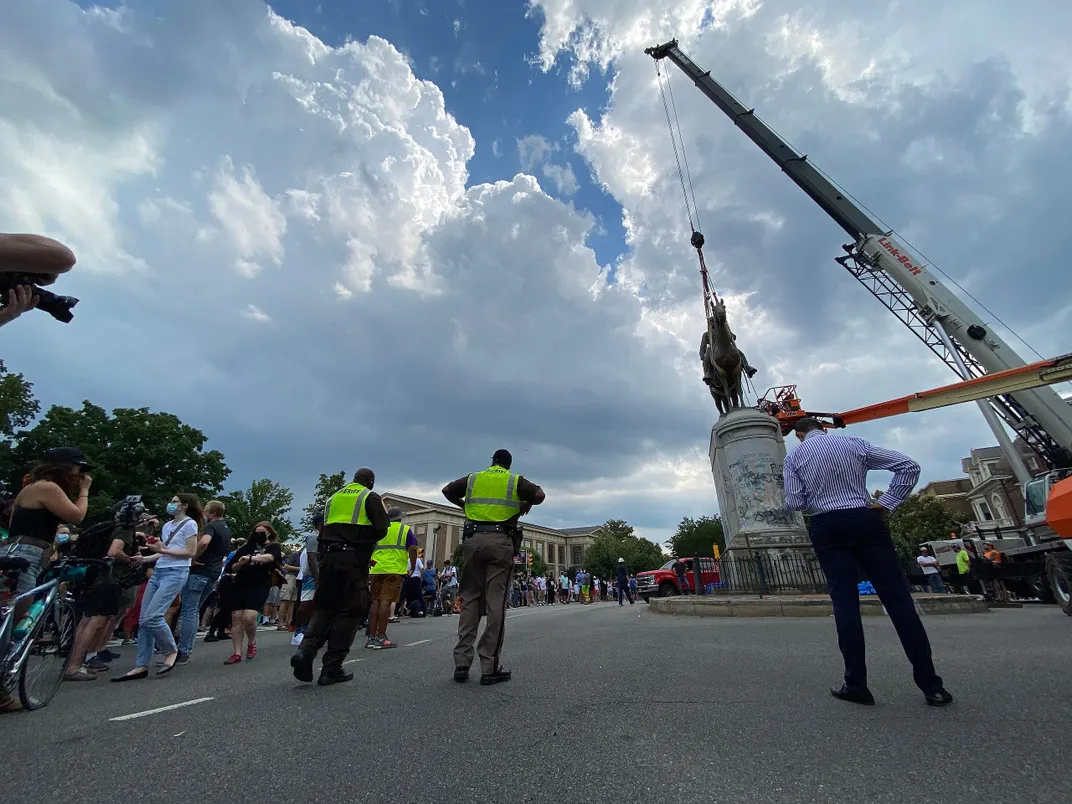Virginia Museum Will Lead Efforts to Reimagine Richmond Avenue Once Lined With Confederate Monuments
Governor Ralph Northam’s proposed budget for the coming fiscal year earmarks $11 million for the project
:focal(384x316:385x317)/https://tf-cmsv2-smithsonianmag-media.s3.amazonaws.com/filer/f8/79/f87980ba-6a24-4c38-908f-76bdd17150fb/protest_art.jpg)
This summer, in the wake of demonstrations sparked by the deaths of George Floyd and other African American victims of police brutality, protesters and city contractors toppled four Confederate monuments along Richmond’s Monument Avenue.
Now, as the United States continues to grapple with the effects of systemic racism, Virginia Governor Ralph Northam has announced plans to dedicate almost $11 million to reinventing the historic boulevard. Eventually, writes Phillip Morris for National Geographic, the politician hopes to “repurpose parts of Monument Avenue to better reflect Virginia’s and America’s diverse heritage and not shy away from hard truths about the racially divided past.”
Per a statement released last week, Northam’s proposed budget for the coming fiscal year allocates $25 million to transforming historic sites across the state. To bring this plan to fruition, the governor will need spending approval from Virginia’s Democratic-controlled General Assembly.
“These investments will help Virginia tell the true story of our past and continue building an inclusive future,” says Northam in the statement. “At a time when this Commonwealth and country are grappling with how to present a more complete and honest picture of our complex history, we must work to enhance public spaces that have long been neglected and shine light on previously untold stories.”

In addition to earmarking funds for reimagining Monument Avenue, the budget designates $9 million for the development of a “Slavery Heritage Site” and renovation of Richmond’s Slave Trail—a walking path that traces the history of enslaved individuals in Virginia through 1865. Another $5 million will be used to repatriate tombstones from the former Columbian Harmony Cemetery, an African American burial ground that was excavated and moved to another site in 1960 to pave the way for commercial development.
“I was horrified when I discovered the headstones from Columbian Harmony Cemetery scattered along two miles of shoreline on the Potomac River,” says State Senator Richard H. Stuart in the statement. “With the help of this funding, we will be able to return many of these to a better and more respectful resting place.”
As Gregory S. Schneider reports for the Washington Post, Northam asked the Virginia Museum of Fine Arts (VMFA) to spearhead the community-driven Monument Avenue project. (The Richmond museum is home to Rumors of War, a 2019 Kehinde Wiley sculpture created in direct response to the Confederate statue–lined promenade; per the VMFA’s website, the piece mirrors a statue of a Confederate general but commemorates the “African American youth lost to the social and political battles being waged throughout our nation.”) The governor is also soliciting donations from such organizations as the Andrew W. Mellon Foundation, which recently pledged $250 million toward creating new, racially inclusive monuments.
The Monument Avenue project’s budget would designate $750,000 for planning and $10 million for implementation. Per Dean Mirshahi and Laura Perrot of ABC News, the campaign is slated to begin with renovations of the Robert E. Lee Circle, which surrounds a much-discussed monument to the Confederate general.
“This is potentially a model for other parts of Virginia, other parts of the United States [or] other parts of the world as people struggle with monuments—when to create them, when to take them down,” Alex Nyerges, the VMFA’s director, tells the Post. “What we hope is to create a vision that unites us and brings us together.”
/https://tf-cmsv2-smithsonianmag-media.s3.amazonaws.com/filer/dc/01/dc01a758-30df-47b1-859a-0976db022af8/rumors_of_war.jpg)
Home to more Confederate statues than any other state (110 in 2019, according to the Southern Poverty Law Center, or SPLC), Virginia has emerged as the epicenter of the debate over public works honoring slaveholders, the Confederacy and other controversial historical figures. But Confederate monuments remain prevalent outside of the state, too: A 2019 survey conducted by the SPLC identified 1,747 Confederate symbols across the U.S.
Arguably the most recognizable symbol of the ongoing cultural clash is the 21-foot bronze sculpture of Lee—now the only Confederate sculpture still standing on Monument Avenue. During this summer’s protests, activists strove to reclaim the Confederate symbol by plastering its base with brightly colored graffiti and projecting images of victims of police brutality onto its pedestal.
“The power of the canvas is why our art worked,” Alex Criqui, an artist who organized the projections with friend Dustin Klein, tells National Geographic. “The Lee monument was specifically created as a symbol of white supremacy. By putting a Black man’s image on the statue, we created something that no one in Richmond could have likely visualized before we did it.”
Though Northam ordered the Lee monument’s removal in early June, a number of setbacks have delayed the process. As Sarah Rankin reported for the Associated Press shortly after Northam’s announcement, a Virginia court temporarily blocked the governor’s administration from removing the equestrian sculpture after a local man argued that the state remained party to an 1890 deed agreeing to “faithfully guard” and “affectionately protect” the statue, its pedestal and the ground on which it sits. A circuit court judge ruled in Northam’s favor in October, but plans remain on hold while locals appeal to the Supreme Court of Virginia.
Speaking with the Post, Richmond resident Alice Massie says that a recent neighborhood poll of more than 200 households near Monument Avenue found that “all but a handful” supported the statue’s removal.
She adds, “The future should embrace a residential neighborhood that welcomes everyone.”
/https://tf-cmsv2-smithsonianmag-media.s3.amazonaws.com/accounts/headshot/Isis_Davis-Marks_thumbnail.png)
/https://tf-cmsv2-smithsonianmag-media.s3.amazonaws.com/accounts/headshot/Isis_Davis-Marks_thumbnail.png)